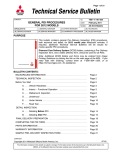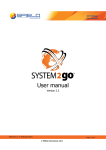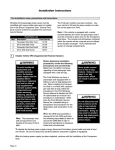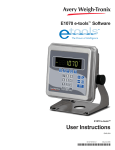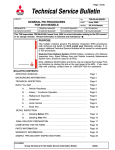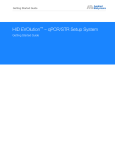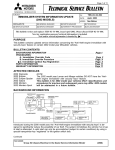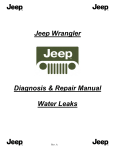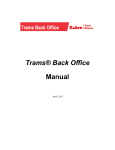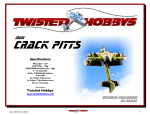Download mitsubishi motor sales of canada, inc. best backed pre
Transcript
MITSUBISHI MOTOR SALES OF CANADA, INC. BEST BACKED PRE-DELIVERY INSPECTION POLICY MANUAL THE PURPOSE OF THE BEST BACKED PRE-DELIVERY INSPECTION The Best Backed Pre-Delivery Sales and Service Worksheets and Procedures have been designed to ensure we live up to the “Best Backed Cars” promise and are aimed at achieving the highest customer satisfaction possible. This policy manual contains General Technical Pre-Delivery Inspection information for all Mitsubishi models. Additional model-specific PDI procedures are frequently issued in the form of Technical Service Bulletins and will be posted for your reference. We have redefined this policy manual based on JD Power and Maritz dealer performance survey data that identifies that our customers are less than satisfied with our PDI and new car delivery performance and ranked them below industry standard. As a result, the following process has been developed with revised inspection worksheets in an effort to improve the process and ensure we meet and exceed our customers’ expectations. The PDI process is essential to the ongoing success of your business. Examples of the impact the PDI process can have on the success of your dealership are listed below: Performance can positively or negatively impact overall customer service and sales service indexes. A positive PDI experience can help your dealership generate repeat business and/or help you capitalize on word of mouth referrals all of which encourages additional vehicle sales and service work. Informed new owners get the most out of their vehicle, feel good about their purchase, and, are more apt to stay loyal to our brand. As a result, avoid pressure to rush through the PDI or skip steps on the PDI worksheets. 1 TABLE OF CONTENTS The Purpose of the Best Backed Pre-Delivery Inspection……..……. Page 1 Table of Contents………………………..…………………………..........Page 2 Protecting New Vehicles Awaiting Delivery……………………………..Page 3 Pre-Delivery Warranty Claims….………………………………………...Page 3 The Best Backed Service Pre-Delivery Process…………………………Page 4 -21 a. Vehicle Information Verification……………………………....Page 4 b. Detailing the vehicle prior to PDI……………………………....Page 4-5 c. Qualified Mitsubishi Technical Inspection General…………Page 6 d. Exterior Walkaround Inspection………………………………..Page 6-8 e. Under Hood Inspection………………………………………...Page 9 f. Under Vehicle Inspection…………………………………….....Page 10 g. Trunk Inspection………………………………………………....Page 11 h. Interior Vehicle Inspection…………………………………..….Page 11-13 i. Verification of Owner Items…………………………………....Page 13 j. Road Test……………………………………………………..…Page 14-18 k. Detailing After PDI…………………………………………..….Page 18-20 l. Authorization and Acknowledgement………………………… Page 20 m. Next Steps…………………………………………………….. Page 21 6. The Best Backed Sales Delivery Process………………………………..Page 22-26 a. Salesperson Vehicle Quality Control Check………………... Page 22 b. Salesperson Administrative Check…………………….……. Page 22 c. Salesperson Administrative Review with Purchaser(s)…… Page 23 d. Parts and Service Department and Personnel Introduction. Page 24 e. Salesperson Exterior Walk Around with Purchaser(s)………Page 24 f. Salesperson Vehicle Interior Review with Purchaser(s)…….Page 25 g. Salesperson and Purchaser Test Drive……………………… Page 25 h. Acknowledgement……………………………………………… Page 26 i. Vehicle Registration and In Service Date……………………. Page 26 7. PDI Materials and Resources…....………………………………………. Page 27 8. Sample Forms and Labels………………………………………………....Page 28-30 a. Best Backed Service Pre-Delivery Worksheet …….……….. Page 28 b. Best Backed Sales Delivery Worksheet……….……………. Page 29 c. Sample of the Diamond Care Roadside Assistance Label… Page 30 d. Sample of the Quality PDI Inspection Guaranty Label.…..... Page 30 1. 2. 3. 4. 5. 2 PROTECTION OF NEW VEHICLES The protection and maintenance of new vehicles awaiting retail delivery is the responsibility of the Dealer. Any claims arising from deterioration, damages or shortages that occur during, or result from, storage of new vehicles will not be considered for reimbursement by MMSCAN. Dealers should take the following precautions in order to protect new vehicles: a) Once a month, the vehicle should be started and driven. b) Store new vehicles in a protected location with the protective wrap removed. c) Periodically wash unwrapped vehicles in storage to prevent the accumulation of smoke, soot, industrial and environmental deposits. d) The battery should be fully charged, prior to storage, and be maintained in a charged condition for the duration of the storage period. Disconnect all electrical components that may cause a discharged condition during prolonged storage. e) Ensure all fluids are at an adequate strength to withstand seasonal temperature variations. f) Check and adjust tire pressures as necessary. g) Move the new vehicle occasionally to avoid flat spots on tires. PDI WARRANTY CLAIMS Your dealership is responsible to enter one PDI warranty claim into the Mitsubishi Warranty Claim System. The Warranty system can be found under pathway: Service/Systems/Claim Entry. Additional repairs and/or adjustments caused by a defect in materials and/or workmanship that are not part of these published PDI procedures should be claimed on a separate warranty claim. Use the applicable published LOTS labour time for the repair or the “zero-zero” actual time procedure for nonpublished repairs and/or adjustments. NOTE: Duplicate warranty PDI claims will automatically be rejected by the Warranty Claim System. 3 Failure to retain a completed copy of the Best Backed Pre-Delivery Service Checklist and a substantiating repair order in the customer’s service file could result in cancellation or chargeback of the PDI and/or all warranty claims against that vehicle. Any subsequent repair that relates to an inadequate PDI will not be claimable or approved by MMSCAN. THE BEST BACKED SERVICE PRE-DELIVERY PROCESS All new vehicles received by the Dealer are not ready for immediate delivery to the retail customer. Every new vehicle must first be given a Best Backed Service Pre-Delivery Inspection and necessary adjustments must be made prior to delivery to the retail customer. The Dealer must assign responsibility for the inspection to a Qualified Mitsubishi Technician. They must inspect and adjust the new vehicle in accordance with the Best Backed Service Pre-Delivery Checklist (see sample) and the step by step process guideline outlined below. The PDI process should take 1.5 to 2.0 hours and should be and will be verified by the Technician punch time. Schedule new vehicle preparation far enough in advance of delivery to avoid any unforeseen delivery delays. Time should be allotted for potential required repairs and coordinated with other shop work which is already in progress. VERIFY VEHICLE INFORMATION Before you start, accurately record the vehicle information requested at the top of the Best Backed Service Pre-Delivery Inspection Worksheet. This information includes: the inspection date, the dealership code, the customer(s) full name(s), the vehicle model/year/colour/VIN. It is important to record the information accurately to avoid PDI chargebacks or customer service issues at a later date. DETAILING THE VEHICLE PRIOR TO PDI The Detail Specialist should detail the vehicle prior to handing off the vehicle to the Technician for PDI. Before commencing, please ensure your hands and uniform are clean and free of sharp objects in order to prevent unintentional damage to the vehicle. 4 1. Remove RAP-FILM protective covering from all body surfaces Before a Technician can perform the Technical portion of the PDI, the protective film (RAP-FILM) must be removed from all exterior body surfaces. a. It is recommended that protective rap-film is removed immediately when a new vehicle arrives at the dealer to confirm that there are no hidden damages. This will avoid untimely repairs and rescheduling delivery of the vehicle to the customer. b. For easy removal, the temperature of the RAP-FILM should be between 0°C and 50°C. If the temperature of the vehicle body is higher than 50°C (122°F), the film softens, allowing more residues to remain on the body surface. For easier removal, decrease the temperature of the vehicle body surface to less than 40°C (104°F) with cool water and/or store the vehicle inside, out of the sun. OR If the body surface temperature is lower than 0°C (32°F), increase the temperature using warm water or put the vehicle inside a heated facility until the body surface temperature rises. Then, starting at the corners, pull up on the RAP-FILM, fold it back, and pull it off at an angle of 180 degrees to minimize glue residue. 2. Remove all RAP-FILM residue Use either of the following methods to remove the RAP-FILM residue from the body surfaces. The residue is most noticeable at the edges where the film was attached to the body. If there is a considerable amount of residue, remove it by wiping down the affected body surface area with Biosol 100 or Isopropyl Alcohol, diluted 50% with mineral spirits (Petroleum Benzene). OR If there is only a small amount of residue, use a very mild (white) polishing compound on the affected surface area. 5 3. Wash and dry the vehicle exterior 4. Check the paint surface for defects a. Inspect the affected areas for paint swelling. This condition occurs when moisture is trapped between the RAP-FILM and the body panel surface. Most occurrences of paint swelling can be corrected by parking the vehicle in bright sunlight for one hour. If this is not successful, refer to the paint repair procedures in the body repair manual. b. Inspect the paint surfaces for uniform colour. c. Inspect the vehicle from different angles. If any defects (scratches, dings, dents, body damage) are found, contact your Service Manager and schedule immediate repair. d. Check the alignment of all body panels for uniform gaps and flushness. All body panels should be flush with their adjoining panels. Once completed, the Detail Specialist should sign and date the Best Backed Service Pre-Delivery Inspection Worksheet in the allotted space. QUALIFIED MITSUBISHI TECHNICIAN INSPECTION Complete one Best Backed Service Pre-Delivery Inspection Worksheet per vehicle. These worksheets are not specific to a particular model year. Use the Best Backed Service PDI Worksheets as a guide. After completing each step, check-off that procedure on the worksheet. The sequence in which you perform the steps may vary depending on your dealership’s procedures, facilities, and the vehicle model. At the end of your inspection, confirm all steps are checked on the worksheet. For the items identified as “if equipped (*)”, strike through the option if it is not an installed option on that vehicle. Prior to starting your Technical Inspection, be prepared by gathering all required tools. For instance: Obtain the PDI Worksheet Obtain one PDI Quality Inspection Label Obtain one Diamond Care Roadside Assistance Label Check all PDI-related TSBs in Group 00 Check the service manual for model specific information Check the Mitsubishi Dealer Link (MDL) Superscreen for any required open recalls and to ensure no PDI has already been performed on the vehicle (if involved in a dealer trade). 6 NOTE: No new Mitsubishi vehicle is to be delivered if it has an outstanding Recall Campaign. Exterior Walkaround Inspection: 1. Check Remote Keyless Entry/Theft Alarm/Door Locks/Immobilizer a. Remote Keyless Entry (if so equipped) i. ii. iii. iv. v. vi. vii. Check the door and trunk locking and unlocking feature. Make sure the key is removed from the ignition. Close all doors and trunk. Press the “lock” button once to lock all doors. Pressing the “unlock” button once will unlock the driver’s door Pressing it twice “unlocks” all doors. On remotes with three buttons, the third button unlocks the trunk. Press the “trunk” button twice to open the trunk. viii. Press the “Panic” button (if equipped) to test the alarm system. Press it again to turn off the Panic alarm. NOTE: Factory-installed RKE systems have an “answerback” system which can be programmed for various answerback configurations depending on the model and system installed. Make sure the vehicle’s answerback function is in the full-function answerback mode where both the horn and lights signal when the doors are locked. Refer to the vehicle owner’s manual for programming information. b. Theft Alarm (if so equipped) i. Lower the driver’s window. Remove the key from the ignition switch. ii. Open the driver’s door, lock all the doors using the power door lock switch, and close the door. The security light on the instrument panel will be lit for about 20 seconds and then go out. iii. Reach through the open window, manually unlock the door, and then open it. The alarm horn should sound and the headlights should flash. iv. To deactivate the alarm, insert the key into the door or trunk key slot and turn the key. v. Repeat steps on the front passenger’s door and lock, using the trunk remote release and trunk lock, and on the hood release. c. Door Locks and Latches 7 i. Close each door to check the latch mechanism. If adjustments are required, refer to the appropriate service manual. Submit a warranty claim for any adjustment performed. ii. The rear door should not open from the inside when the child lock lever is in the lock position. The lock mechanism is located on the inside rear doors. Once completed, re-set the position to the "unlock" or “FREE” position. d. Fuel Door and Fuel Cap i. With remote release - pull the release lever and make sure that the door opens. Close the door and verify the door latches properly. ii. Without remote release - make sure the fuel door opens and closes properly. Ensure the fuel tank cap has been tightened to avoid the engine light coming on unnecessarily. e. Immobilizer Insert all keys into the ignition switch and make sure that all keys will start the engine without stalling. If the vehicle starts, then stalls, one or more of the keys may not have been registered, or there may be an immobilizer system problem. Refer to the service manual for diagnosis procedures, and use MEDIC and/or the Mitsubishi Dealer Link (MDL) Technical Information/Training extranet site to search for TSBs relating to Immobilizer system subjects and Immobilizer key registration policies and procedures. 2. Check All Exterior Lights. Turn the engine off, then turn the ignition switch to the “ON” position and place the transmission selector in “R” (Reverse) with the parking brake applied. a. Check all lights for chips or cracks in the lenses. b. Make sure all exterior lights operate properly: i. Push the hazard lights button located on the internal dash panel. All four headlights should flash. ii. Place the vehicle into reverse and ensure the reverse lights come on. iii. Check that the high-beam lights are fully operational. 8 iv. On vehicles with AUTO-OFF headlights, turn on the headlights and turn the ignition off. The headlights, side-market lights, and taillights should turn off when the driver’s door is opened. Be sure to turn off all lights after completing your inspection. Return the transmission selector to the “P” (Park) position. 3. Install Loose Items: c. Remove paper place mats and install front/rear floor mats (including locking clips/tabs, if applicable). Also verify the colour match. d. Install the antenna mast and ensure it is operational. If equipped with an automatic antenna, ensure it extends when the radio is on and retracts when the radio and/or key is turned off. Lubricate the mast with dry graphite. e. Ensure the license plate holder is in the trunk. NOTE: Do not install the front plate holder until the vehicle is sold. In the province of Quebec, no front license plate is required by law and this could impact a dealer trade or customer satisfaction. Under Hood Inspection: 1. Verify the operation/lubrication of the hood latch. a. If the hood latch squeaks or demonstrates excessive resistance when opened oil the hood lock release mechanism and hood safety catch ensuring all moveable surfaces are covered. 2. Check Brake/Clutch/Power Steering Fluids a. Check the fluid levels using the scale on the plastic reservoir of both master cylinders (brake and clutch). They should both be at the full mark. If not, fill the reservoir(s) either DOT 3 or DOT 4 brake fluid (Genuine Mitsubishi Brake Fluid, as specified for all Canadian models.). Do not add fluid to the ABS unit reservoir. b. Check the power steering fluid. It should be at the proper level on the dipstick or on the scale on the plastic reservoir. (Use Genuine Mitsubishi Power Steering Fluid, as specified for all Canadian models.) 3. Check Coolant and Windshield Washer Fluids a. Check these fluid levels against the scale on the plastic reservoir. Add fluid if necessary (Use Genuine Mitsubishi Coolant, and Genuine Mitsubishi Windshield Washer Fluid). 9 b. Be sure to check and fill both front and rear windshield washer fluid levels. 4. Check Engine Oil a. Check engine oil level. If oil is needed, check the appropriate service manual for the correct grade of oil. 5. Check the Battery Charge a. Check that the battery, cable terminals, and additional wires attached to the positive terminal are tight and that the battery is secure in the tray. b. Use your dealership’s MidTronics 830 analyzer to ensure the battery is fully charged. If charging is necessary, follow the vehicle service manual procedures and recharge the battery. c. Remove and discard the battery maintenance tag (if equipped). 6. Inspect the Drive Belts a. Do not check the drive belts with the engine running. b. Check the drive belt for cuts and cracks. If necessary replace the belt making sure there is no interference between the belt and any other engine components. c. The tension of the belt should be at the designated point indicated in the owner’s manual. Under Vehicle Inspection: For proper inspection, the vehicle should be placed on a vehicle lift for the under vehicle inspection. Refer to the appropriate service manual for lift points for the under vehicle inspection. 1. Leak Verification a. Check for leaks from all engine components, transmission, fuel lines, coolant hoses, power steering lines, and A/C lines (if so equipped). Specifically look at the fittings and connections. b. Check lines for twists, kinks, and proper routing. 2. Inspect Tires and Tire Pressure. Adjust the tire pressure to the specifications indicated on the tire pressure label on the driver’s side Bpillar a. Check all tires for damage such as cuts, foreign objects in the tire, or any other imperfections. b. If present, remove the tire pressure and tire balance decals from each tire. 10 c. Don’t forget to check the spare tire. To remove the spare tire, remove the installation clamp by turning it counterclockwise. If an adjustment is made, be sure the tire hold down is secure upon replacement. 3. Inspect the Exhaust System Signs of a problem with the exhaust system may include a change in the sound of the exhaust system, the smell of dangerous exhaust fumes, or if the underside or rear of the vehicle shows signs of damage. a. Check for holes or exhaust gas leaks caused by damage. b. Check the joints and connections for looseness or leaks. c. Check the rubber hangers and brackets for damage. 4. Remove Brake Rotor Protection (bags/covers if equipped). Trunk Inspection: 1. 2. 3. 4. 5. Inspect the trunk for easy opening and closing. Inspect the trunk fit. It should be uniform. Ensure all trim is installed properly. Verify the trunk light comes on when open. Check the operation of the T-shaped yellow emergency inside trunk release handle. Open the trunk lid and trip the latch by pushing up on the catch with the shaft of a screwdriver to simulate trunk closure. Remove the screwdriver with the latch in the closed position, and verify the emergency trunk release by pulling the yellow handle. 6. Check for tire tools and jack. The tools are stowed beneath the luggage floor board (tool bag, wheel nut wrench, and bar). The jack is stored under the floor carpet behind the rear seat. Interior Vehicle Inspection: 1. Interior and Instrument Panel Lights: a. Dome light(s). b. Map light(s). c. Vanity mirror light(s). d. Instrument panel illumination and dimmer function. Set the instrument panel at the brightest position. e. Glove box light. f. Door courtesy lights. Place the dome light switch in the position where the light is on when the door is open and off when the door is closed. g. Passenger airbag system cutoff switch and lights (if so equipped). 11 2. Inspect the warning systems: a. Make sure all horn buttons are functional. b. Make sure the hazard lights are operational. 3. Steering wheel lock and release. a. To lock – remove the key at the “LOCK” position. Turn the steering wheel until it is locked. b. To unlock – turn the key t the “ACC” position while moving the steering wheel slightly. 4. Check all seat adjustments, seat belt condition, and head restraint operations. a. Inspect all seat belts and harnesses to ensure they connect, hold, and retract properly. b. Make sure the seat backs for drivers and passenger adjust and lock in all positions. c. Ensure the lumbar support is included in the driver’s seatback. d. Check that the seat track adjuster operates and locks throughout its entire travel (front seats). Pull the seat adjusting lever up and slide the seat forward or backward releasing the lever to lock the seat in place. e. Check power seat operation (if so equipped). Push the switch forward or backward to the desired position. Release the switch and the seat should lock into position. To prevent the battery from running down, operate the power seat with the engine running. f. Inspect the position of the anchors and tethers for children are in good condition and secure. g. Check head restraints. i. To raise the restraint, pull it straight up. ii. To lower the restraint, push down on it while pressing the lock knob. iii. After adjusting the height make sure it holds its position by pushing down on the restraint. h. Check that safety labels regarding seat belts use and air bags are in place. i. Check operation of heated seats (if so equipped). The heated seats operate only when the ignition is on. Check both high/low/off functions and that the indicator light illuminates when in operation. 5. Brake Free Pedal Play (if equipped): a. Turn off the engine and press the brake pedal several times with your foot. b. Then press the pedal down with your fingers until you first feel resistance. c. The brake pedal free play should be between 0.1 and 0.3 inches. 12 6. Inspect window operation. a. Check for proper window tracking, complete up and down and proper sealing. b. Check the lockout and auto-down functions on vehicles with power windows. c. Check the front and rear window defogger operate properly. This should be verified with the engine running and allowing time for the defogger to warm up. 7. Inside/outside mirror operations. a. Check and try adjusting the exterior mirrors. b. Make sure the inside mirror holds its adjustment. c. Make sure the anti-glare function operates properly. d. Ensure exterior heated door mirrors operate (if so equipped). When you place your hand on the mirror you should be able to feel/see it heating up. 8. Sun visors are installed properly and include safety labels. 9. Inspect sunroof or convertible top operation. a. All function controls should work properly. b. The sunroof should close tightly and the tilt-up feature (if equipped) works. c. Open and close the sunroof a few times to make sure the timing of the functions operate properly. d. On convertibles, make sure all windows lower automatically when opening and closing the top. Make sure engine is running during this operation. Check convertible top latch operation. If adjustments are required, refer to the appropriate service manual procedures and submit a warranty claim for the adjustments. 10. Entertainment System (if so equipped). a. Inspect to ensure the system is operational. b. Check for inclusion of all entertainment system components. 11. Cargo cover/nets (if so equipped). a. The cargo cover will be located in the trunk and should be installed and tested for ease of operation. b. The cargo nets will be located in the trunk and should be installed. For installation instructions see the vehicle’s owner’s manual. 12. Cigarette lighter / auxiliary accessory sockets (if so equipped). a. Push in the lighter. 13 b. After it pops out, visually check the element turns orange from the heat. c. Check any additional auxiliary sockets for proper operation. Verification of Owner Items: 1. Verify the glove box contains one copy of the appropriate owner’s manual (model and correct model year), as well as, one warranty manual. If not, check the parts and accessory guide on the MDL for the correct part number, order the manual, and put a claim for the manual through on your PDI. 2. Set the clock to the correct local time. Place the ignition switch into the “ACC” or “ON” position. This will allow you to view the current display time. If the clock needs to be reset, press the “H” (hour) button until the correct hour appears. Then press the “M” (minute) button until the correct minute appears. 3. Preset radio stations and verify functionality. a. Check reception of both AM and FM stations. b. Set all “AM”, “FM1”, and “FM2” preset buttons to a variety of strong local stations. c. Check CD player/changer (if so equipped). d. Check for rattling or vibrating speakers. e. Adjust the volume, treble, bass, balance, and fader controls to their centre position after radio inspection. 4. Obtain a copy of the sales contract and inspect the vehicle to ensure all contract Genuine Mitsubishi Accessories are installed on the vehicle prior to delivery. Once confirmed, check the MDL (Service/Warranty/Dealer Options) to make sure the accessories have been listed as installed either by the factory as an option or by your dealership. Road Test: Vehicles should be at operating temperature prior to performing the tests below. Before conducting a road test, establish a route that allows for a variety of different road conditions, and that you will be able to use for every test. This route should be relatively free from traffic so you can safely conduct the test and concentrate on the operation and performance of the vehicle being tested. Always follow all traffic laws and safe driving practices. 14 If the vehicle is equipped with air conditioning, place a thermometer in the centre vent before beginning your road test. This will be used later to check the A/C operation. The recommended road test duration is a minimum of 20 kilometers. 1. Start by recording the beginning odometer in the allotted space on the Best Backed Service Pre-Delivery Inspection Worksheet. 2. A/T Shift Interlock a. Make sure the shift lever can only be moved when the brake pedal is depressed and the key is in the unlocked position. 3. A/T Starter Interlock a. Make sure the engine can be started ONLY when the shift selector is in PARK or NEUTRAL. 4. M/T Clutch – Starter Interlock a. Make sure the engine will start only when the clutch pedal is depressed. 5. Warning, Indicator Lights and Gauges Turn the ignition to the “ON” position. The indicator and warning lights shown in the illustration should be on (as equipped). a. Start the engine and verify all indicator lights go out, including the Check Engine light. b. The brake warning light should be lit when the parking brake is applied. c. Verify that all gauges and lights are working (as equipped). d. Check the operation of the seat belt warning buzzer and the key reminder buzzer. 15 6. Electronic Compass (if equipped) a. Refer to Group 52A in your service manual for electronic compass calibration instructions. b. Check the compass variance (the difference between the earth’s magnetic north and true geographic north poles). If compass variance is not adjusted properly, the compass can give false readings. c. The electronic compass requires calibration when the power is disconnected (removing the battery cable or disconnecting the IOD connector). 7. M/T: Check Clutch and M/T Operation (if equipped) a. Check for proper clutch operation and smooth shifter/transmission operation. b. Repeatedly shift up and down at least ten times at idle speed and at speeds of under 64 kmph. 8. A/T: Check A/T Operation a. From 40 kmph, accelerate to full throttle. The transmission should kick down to 1st gear and then shift to the higher gears. Remember to follow all traffic laws and safe driving practices. b. Idle for 20 seconds in “N” then shift to “D” then “R” holding at each position for more than 3 seconds. c. Check for smooth shifting during normal driving. Then upshift from 1 to 4 with 20% and 30% throttle and decrease to stop. On with SportronicTM, slide the shift lever into the “Sport Mode” slot and upshift and downshift to verify proper operation. 9. 4WD and AWD: Check Transfer Case a. Check for proper engagement and disengagement in all 4WD modes. For detailed explanation of the Transfer Case Operation, refer to the Owner’s Manual. 10. Check Engine Performance Check the vehicle’s engine performance under the following conditions. Remember to follow all traffic laws and safe driving practices. a. Part Throttle – with the vehicle at a constant speed (40-56 kmph), engine performance should be smooth and without hesitation. b. Under Load – accelerate to three-quarters throttle. The vehicle should accelerate smoothly, without laboring or hesitation. c. At Cruise – with the vehicle at a constant speed (70-88 kmph), engine performance should be smooth, without hesitation or surging. 16 11. Check Cruise Control a. Accelerate to 30 kmph. b. Turn on the MAIN switch. Make sure the CRUISE light illuminates. c. Activate the SET function to set the vehicle speed. The vehicle speed should hold at 30 kmh. d. Increase the vehicle speed slightly by activating the RESUME function momentarily. e. Check each canceling function by depressing the brake, clutch (M/T only), and by activating the CANCEL button. f. Resume the set speed by activating the ACC/RESUME button. Please note the cruise control will not operate below 25 kmph. g. Turn the cruise control off by pressing the MAIN switch. 12. Squeaks, Rattles, and Wind Noise Check for any abnormal noise and vibration during your road test, including driveline, pedal, or steering wheel vibration. On convertibles, while parked, close the top. Be sure to close all windows and sunroof and turn off the audio during this part of the inspection. 13. Steering Operation and Wheel Alignment Make sure the steering wheel is centered when the vehicle is traveling straight ahead. The vehicle should track straight on a level surface, without pulling or drifting. If a problem is identified, correct it prior to delivery of the vehicle. Refer to the service manual for adjustment procedures. 14. Brake Performance and ABS Operation a. Brake Performance – the vehicle should brake smoothly and in a straight line. There should be no abnormal noise or vibration during braking. Brake pedal feel should be firm, not soft or mushy. b. ABS Operation Caution: no vehicles should be behind you when you perform the ABS brake check. During hard breaking, the vehicle should come to a controlled, straight stop. You will feel some pedal pulsation and may hear abnormal sounds from the ABS system. 15. Windshield Wiper & Washer Operation (front & rear) a. Windshield washer aim (front & rear) i. Make any needed adjustments, referring to the service manual. ii. Submit a warranty claim for adjustments performed. b. Windshield wiper operation (front & rear) i. Verify correct wiper operation during all speeds. If streaking occurs, clean the wiper blades with a cloth soaked in mild detergent. 17 ii. Make sure the wipers park properly. 16. Heater and A/C Operation (if equipped) a. Check for proper operation of all modes, air intake selection, and temperature control. b. Check the fan speed and for any unusual fan noises. c. Using a thermometer in the centre air outlet, check for proper cooling when the air conditioner is operating. Refer to the service manual for temperature specifications or conditions for the particular model. Make sure the air intake control is in the RECIRC position. 17. Hot Engine Idle Speed with A/C “ON” and “OFF” With the engine at operating temperature, check the idle quality with the air conditioning “ON” and “OFF”. When finished, leave the air intake door in the FRESH position. 18. Check Parking Brake a. Park the vehicle on a slight incline and leave the transmission in NEUTRAL. b. With your foot off the service brake, the parking brake should be able to hold the vehicle. c. Count the number of “click” notches it takes to engage the parking brake. If it is more than 8, adjust the parking brake according to the service manual procedures. 19. Check ATF With the parking brake applied and the engine running, check automatic transmission fluid level. Add or extract fluid if necessary to ensure level is at the HOT marks on the dipstick. 20. Record the odometer reading at the end of your test drive in the allotted space on the Best Backed Service Pre-Delivery Inspection Worksheet. 21. Sign and date the allotted PDI Qualified Technician Signature boxes on the Best Backed Service Pre-Delivery Inspection Worksheet. Leave the worksheet with the vehicle for the Detail Specialist for the after-PDI detailing. Detailing After PDI: 1. Wash All Exterior Body Panels a. Wash all body panels with water, not in direct sunlight. b. Start washing from the roof, working downward, using a sponge and water. 18 c. Always make sure the windows are fully closed. Otherwise, water may enter, causing damage. d. After washing, wiper water from the body surfaces using a chamois or soft cloth. NOTE: When using a high-pressure washer avoid directing high-pressure spray at weather strips. 2. Check for Water Leaks a. The inspection should be performed immediately after washing. b. During storage, when the vehicle was exposed to rain with the RAPfilm removed, or while washing the vehicle, note any water leak conditions that may have occurred and will require repair. c. The source of the water leak is not always located where the leak appears. To accurately locate and repair the leak condition, a through understanding of the circumstances under which the leak is identified must be made known to the person doing the repairs. NOTE: Take adequate time to ensure no evidence of leaks appears. 3. Wash and Inspect All Wheels a. Remove all glue residue b. Wash the wheels with mild detergent and rinse with water. c. After washing, wiper water from wheels using a chamois or soft cloth. d. Inspect wheels and tires for nicks, scratches, and other damage. e. Clean off any residue or foreign material. f. Apply tire dressing to each tire. g. Wipe dry with a clean cloth. 4. Check Door and Trunk Cleanliness a. Under hood i. Remove any debris such as leaves, etc. from the engine compartment. ii. Wipe up any fluid spills and note any evidence of leakage on the repair order. iii. Wipe down the engine compartment components with a damp cloth. 5. Inspect all Glass for Damage and Cleanliness (Inside and Outside) a. Use an approved glass polish to remove minor scratches and imperfections. b. If there is a problem with any glass, follow your dealer’s procedures to correct it prior to delivery of the vehicle. 19 6. Inspect all Mouldings, Trim, and Chrome Parts a. Inspect all for looseness, proper alignment, and cleanliness. b. Clean off any residue. c. Follow the warranty policy and procedures to claim for any corrective repairs. 7. Inspect all Weather-stripping and Rubber Mouldings. a. Look for any evidence of damage. b. Make sure they are mounted correctly. c. Clean off any residue. 8. Clean the Interior Panels and Trim for Proper Fit. a. Wipe plastic interior components with a soft damp cloth. b. Remove minor stains and soil using a mild detergent, then wipe dry with a clean, soft cloth. 9. Check the Headline and Sun Visor Cleanliness. If stains or soils are found on either, do the following: a. Clean with mild soap solution or reliable vinyl cleaner. b. Apply a small amount of solution with a clean cloth or sponge and work into lather, then wipe with a damp cloth. c. When the lather has been removed, wipe again with a soft, clean cloth. 10. Check for Stains, Dirt, Scuffs, or Tears. If stains or soils are found on either, do the following: a. Clean with mild soap solution or reliable vinyl cleaner. b. Apply a small amount of solution with a clean cloth or sponge and work into lather, then wipe with a damp cloth. c. When the lather has been removed, wipe again with a soft, clean cloth. NOTE: Damage and/or stains which cannot be removed using the above method should be noted on the repair order and corrected prior to customer delivery. 11. Check the Door Edge Guards (where applicable) a. Check that the door edge guards are in the proper position and are securely fastened. Authorization and Acknowledgement Ensure all items listed on the Best Backed Pre-Delivery Service Inspection Worksheet have all been checked and repairs where necessary have been completed. 20 The Service Manager should carefully inspect and road test each new vehicle. They should feel comfortable to certify that the services performed by the assigned Qualified Mitsubishi Technician are satisfactory for vehicle delivery to our retail customer. Sign and affix the Mitsubishi Quality Assurance Inspection Label on the inside of front windshield in the lower right corner. Apply the Roadside Assistance Label on the inside of the front windshield in the lower right corner. Once satisfied, both the Service Manager and the Qualified Mitsubishi Technician should sign the Best Backed Pre-Delivery Service Inspection Worksheet under the acknowledgement space allotted. Next Steps The Service Manager should return the completed and signed Best Back PreDelivery Service Worksheet to the salesperson making the delivery to the customer. The dealership copy of the worksheet should be used to initiate a service file for the vehicle. The Service copy of the form must be retained at the Dealership in the customer’s service file. 21 THE BEST BACKED SALES DELIVERY PROCESS New vehicles received by the Dealer are not ready for immediate delivery to our retail customers. Each new vehicle must first be given a Best Backed Service Pre-Delivery Inspection followed by a Best Backed Sales Delivery Inspection prior to handing over the keys. Only one Best Backed Sales Delivery Inspection Worksheet should be completed per vehicle delivery. All items on the worksheet should be installed, demonstrated, and inspected to both the Salesperson’s and Purchaser(s) satisfaction. Based on the current industry average the sales delivery process should be a minimum of forty-five (45) minutes to complete properly and efficiently. The vehicle Salesperson is responsible for the preparation and delivery of the Purchaser(s) vehicle. In accordance with the Best Backed Sales Pre-Delivery Inspection Worksheet and process outlined herein, the Salesperson must ensure the vehicle is acceptable for delivery, all administrative paperwork is completed, the Purchaser(s) have been provided with necessary program information (e.g. warranty coverage, maintenance schedules, service hours…), the interior and exterior of the vehicle are verified for condition, and all safety features are demonstrated. SALESPERSON PRE-DELIVERY VEHICLE QUALITY CONTROL CHECK Obtain a copy of the Best Backed Service Pre-Delivery Worksheet from your dealership Service Manager. Verify the all fields on the worksheet have been completed, and the acknowledgement was signed and dated by both the Qualified Technician and Service Manager at your dealership. The day prior to delivery of the new vehicle to the Purchaser, verify the vehicle exterior and interior for cleanliness as well as overall fit and finish. Ensure the new vehicle has a full tank of gas for the test drive and the tire pressure is double checked to ensure a smooth ride. A lapse in time between the Service Pre-Delivery Inspection and Sales Delivery dates may lead to additional last minute touch up requirements. Confirm that the clock has been programmed to the correct local time and the radio stations have been pre-set to the most popular local stations. SALESPERSON ADMINISTRATIVE CHECKS There are a few documents which must be completed prior to delivery of a new vehicle to the Purchaser(s). Prior to the scheduled new vehicle delivery date, 22 ensure the title and licensing work is completed, the financing has been arranged and confirmed, and the Purchaser(s) have arranged for insurance coverage. If these have not been completed, contact your Purchaser(s) immediately to discuss if re-scheduling the delivery date will be necessary. Confirm with your Service Department the new vehicle delivery time and that you will be bringing a new Purchaser(s) to the department for introductions. Ensure the vehicle is placed in a convenient location and is ready to be test driven. SALESPERSON’S ADMINISTRATIVE REVIEW WITH THE PURCHASER(S) Be on time to greet your new vehicle Purchaser(s) at a pre-established time and location at your dealership. Make sure the Purchaser(s) file is on hand and you have obtained a copy of the Best Backed Pre-Delivery Inspection Pamphlet, the owner’s manual from the vehicle, a tire warranty booklet, the warranty and maintenance manual, and a roadside assistance pamphlet. Confirm the accuracy of the Purchaser(s) name and address on file to ensure the most accurate and recent customer information is captured. Record the correct information at the top of the Best Backed Sales Delivery Inspection Worksheet. The vehicle information should also be double checked for accuracy. The required information includes: the delivery date, the dealership code, the customer(s) full name(s), the vehicle identification number (VIN), odometer reading at the time of delivery, the scheduled date for follow up. It is important to record this information accurately to avoid PDI charge back or customer service issues at a later date. Review with your Purchaser(s): a. The customer completed and signed copy of the Best Backed Service Pre-Delivery Inspection Worksheet. This will help demonstrate that your dealership has taken the time and effort to ensure their utmost satisfaction with their new vehicle and will justify customer costs. b. Review the contents of the owner’s manual. Be sure to point out the factory recommended maintenance schedule and customer service telephone numbers. c. Explain that warranty covers defects in manufacturer defects in material or workmanship for specified periods of time and distance travelled. 23 i. ii. iii. iv. 10 year / 160,000 kms Powertrain Warranty 5 year / 100,000 kms New Vehicle Limited Warranty 5 year / Unlimited kms Roadside Assistance Emissions Warranty The Purchaser(s) should understand it is an owner’s responsibility to perform regular service maintenance, service replacement items, and accident repairs. PARTS & SERVICE DEPARTMENT INTRODUCTION Encourage repeat service business by familiarizing your Purchaser(s) with the parts and service department and personnel. Identify your dealership service department location within the dealership, hours of operation, and contact numbers for booking appointments. Introduce your dealership Service Manager to the Purchaser(s) and ensure they get a copy of the Service Manager’s business card. Seize the opportunity and assist your customer in booking their 1st scheduled maintenance appointment. SALES PERSON EXTERIOR WALK AROUND WITH PURCHASER(S) Together the Salesperson and the Purchaser(s) must visually examine the exterior appearance of the vehicle at the time of delivery. a. Confirm there are no paint scratches, dents or flaws requiring repair. b. Identify the new vehicle labels designed to ensure the quality and satisfaction of the new vehicle. For example, the signed Service Technician Quality Assurance Label is our guarantee your vehicle has been inspected thoroughly for any manufacturer defect or flaw, and the Diamond Roadside Assistance Label has been affixed to ensure Purchaser(s) safety should an unforeseen accident arise. c. Demonstrate the operation of all keys and remotes. d. Show the Purchaser(s) how to release the vehicle hood. Once open, point out where the fluid containers are located and identify the full fluid levels your team has verified. Be sure to cover the engine oil, A/T fluid, brake fluid, coolant, and washer fluid locations. While under the hood, identify the location of the block heater and/or block heater plug. e. Demonstrate the trunk fit & finish as well as the functionality. Once open, show the Purchaser(s) the location of the spare tire, jack, and 24 tools in case of emergency, show the emergency trunk release lever and light, and the rear seatback release where applicable. SALESPERSON VEHICLE INTERIOR REVIEW WITH THE PURCHASER(S) Familiarize your Purchaser(s) with the interior characteristics of their new vehicle. a. Demonstrate the operation of the instrument panel controls including gauges and warning lights. b. Show the purchaser(s) how to operate hazard lights, headlights, turn signal operation. c. Per the new vehicle sales contract, show your Purchaser(s) all factory and/or dealer installed accessories. d. Demonstrate door power lock/unlock features and show the Purchaser(s) how to operate rear door child safety locks. e. Take the opportunity to show the Purchaser how to adjust their new vehicle’s seat belts, mirrors, head rests, seats and steering column to the settings most comfortable for them. f. Demonstrate audio equipment. g. Demonstrate navigation system (if equipped). SALESPERSON AND PURCHASER TEST DRIVE The Salesperson should conduct the new vehicle road test to demonstrate to the Purchaser(s) how to get the most out of his or her new vehicle. The purpose should be to improve the Purchaser(s) knowledge of their new vehicle characteristics and proper vehicle handling. Informed customers get the most satisfaction out of their vehicles and are more apt to stay loyal to our brand as a result. On the road test the Salesperson should: a. Demonstrate the proper use of A/T, M/T, or S/T, whichever is applicable. b. Depending upon the vehicle explain the use of 2WD, 4WD, AWD. c. Show the vehicle steering wheel is centered and does not have a tendency to drift or pull. d. Describe and demonstrate safety systems including: TPSMTM, brake performance, Active Skid and Traction ControlTM and Refined Safety Impact EvolutionTM. 25 e. Emphasize the value added factory or dealer installed accessories such as but not limited to: cruise control, sunroof, navigation or entertainment systems. Once you have demonstrated the characteristics and features of the vehicle on a road test, allow the Purchaser(s) the chance to road test the vehicle for themselves. ACKNOWLEDGEMENT Allow the Purchaser(s) the time to ask questions or raise any concerns they may have. Once any questions or concerns have been addressed, both the dealership Salesperson and the Customer should sign and acknowledge all items outlined on the Best Backed Sales Delivery Inspection Worksheet were inspected, explained and demonstrated to their satisfaction. The Salesperson should provide their business card to the Purchaser(s) should the Purchaser(s) have any further questions. A business card is also a good way to capture word of mouth referrals to friends and family. Advise the Purchaser(s) they may be surveyed about the sales and service received by your dealership. The Salesperson should retain the identified copy in the vehicle service file. The customer should retain the identified bottom copy for their records in their PreDelivery Inspection Package to be kept in the customer(s) glove box for easy reference. The dealership should schedule a follow up call within 48 hours of the new vehicle delivery to ensure the Purchaser(s) continued satisfaction with their purchase. This is an excellent time to ask for referral business and/or offer a “bird dog” reward (if any). VEHICLE REGISTRATION AND IN SERVICE DATE Immediately upon delivery of the vehicle to the retail customer, or beginning of service as a Dealer demo, Company vehicle, or Lease vehicle, the New Vehicle Information Statement (“N.V.I.S.”) must be registered using the MDL system. The Warranty Registration Date or in service date will be used to confirm eligibility for “factory” warranties and other applicable service programs offered by Mitsubishi Motor Sales of Canada, Inc. Make certain the customer understands this, and that the same date appears on the bill of sale. NOTE: Vehicles must be registered immediately upon being placed into service. Do not wait until month-end. Remember to register all Genuine Mitsubishi 26 Accessories installed at the time of delivery to ensure maximum warranty coverage. PDI MATERIALS AND RESOURCES This procedure manual contains samples of the Best Backed Sales and Service Pre-Delivery Inspection Worksheets. One of each of these forms is required for each new vehicle delivery. All fields need to be completed and signed. Note: Don’t forget to check the Parts and Service Bulletins for all model specific verification requirements. The MDL Service Superscreen should also be checked for any open recalls requirements prior to delivery of the vehicle. The required PDI materials shown below can be ordered from the parts department using the listed part numbers. Description Part Number Pre-Delivery Inspection Package (English) Quantity of 25 Pre-Delivery Inspection Package (French) Quantity of 25 Pre-Delivery Inspection Labels (English) Quantity of 100 per roll Pre-Delivery Inspection Labels (French) Quantity of 100 per roll Diamond Care Roadside Assistance Labels (Bilingual) Quantity of 100 per roll BBVDS-10-001ENG BBVDS-10-001FR BBVDL-11-001E BBVDL-11-001F ROADLABEL-06-01 27 SAMPLE l, Bilingual Diamond Care Roadside Assistance Label SAMPLE 2, Mitsubishi Quality Assurance Inspection Label































